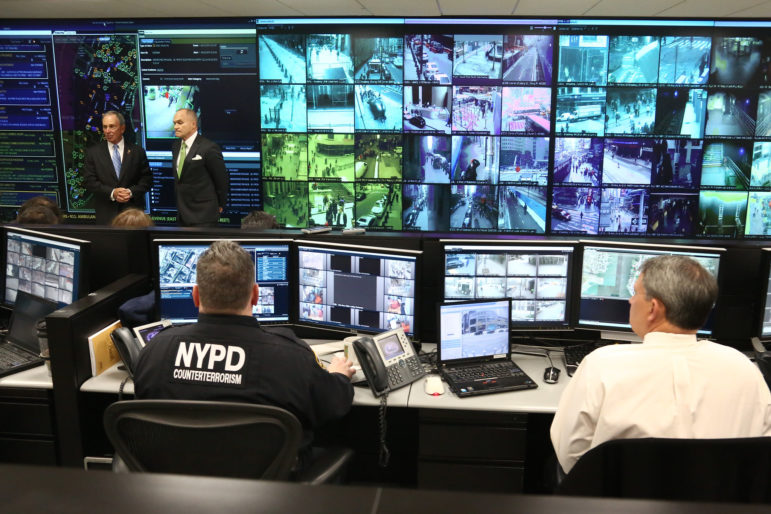‘Contrary to Mayor Eric Adams’ recent rhetoric, there is no technology that will de-bias and constitutionalize stop and frisk. Tech-washing harmful political strategies will not transform those strategies beyond their racist underpinnings.’

NYC Mayor’s Office/Edward Reed
Mayor Bloomberg visiting NYPD counterterrorism personnel in lower Manhattan on April 23, 2013.During President Joe Biden’s visit to New York City in February, New York Mayor Eric Adams called for a “9/11-type response” to gun violence, which he equated to “domestic terror.” For New Yorkers still experiencing surveillance as a result of the domestic response to the events of 9/11, this rhetoric is alarming.
The actual response to September 11th brought with it a massive investment in surveillance systems and major sacrifices of civil liberties in the name of security. Closed-circuit cameras proliferated. Fusion centers were established and began collecting database resources. Data became law enforcement king. And COINTELPRO-era priorities were reinforced, as the physical and electronic surveillance of racial justice advocates, Muslims, Black and Latinx youth, and protesters once again dominated domestic “intelligence” activities. Nowhere was more central to these investments than New York City.
Twenty years after 9/11—and well before the last two years’ alleged rise in gun crime—the NYPD has already blanketed New York City in a vast network of surveillance tools, from license plate readers to surveillance cameras, social media monitoring softwares to gunshot detectors. These investments transformed our city into a Gotham of hyper-visibility. For no one has this been more true than the Black and brown young men who are routinely the target of NYPD’s gaze. And for years, the criminal legal system has been full of cases where the NYPD has used military-grade technology for even the smallest of legal infractions (like jumping a turnstile to the subway).
Instead of investing in these systems further—in a misguided effort to combat a so-called “crime wave” that these tools did nothing to stop or ameliorate—we must act now to rein in the NYPD’s development and use of surveillance technologies.
Contrary to Mayor Eric Adams’ recent rhetoric, there is no technology that will de-bias and constitutionalize stop and frisk. Tech-washing harmful political strategies will not transform those strategies beyond their racist underpinnings. Instead, evidence shows that these technologies are not the crime-ending, unbiased elixir politicians are peddling them to be.
The real project of these surveillance systems can be seen in the review of one of the NYPD’s least discussed, but arguably most terrifying systems: the complex surveillance platform called the Domain Awareness System (DAS). Developed in direct response to 9/11, the DAS aggregates all surveillance, policing, and intelligence information which the NYPD accesses or generates, regardless of source. The DAS includes sealed records, closed-circuit video footage from cameras located all over the city, and social media information for children as young as 12, among many other data points. NYPD officers then use the system to search all of that information—for any reason—and to generate predictions based on that data.
Costing more than $300 million, the NYPD originally built the DAS under the now-worn banner of counterterrorism, but since its creation, zero foiled terrorism threats have been attributed to DAS surveillance. Instead, like many surveillance tools created to “combat terrorism,” NYPD’s developers soon turned the DAS from a carefully-guarded counterterrorism tool to a mobile application for general policing. Cellphones and tablets loaded with the app have been provided to all 36,000 NYPD officers.
Police need no warrant and no approval to either input information about your life and movements into DAS or to analyze it for any reason. For example, DAS houses five years of scanned license plate images generated by nearly 500 readers. Blanketing the city in digital eyes, DAS holds more than 2 billion plate scans, literal location records for countless drivers. With this data, DAS allows the NYPD to predict where any individual car will be in NYC at any given time.
The NYPD’s cataloging of your movements reveals not only where you’ve been or where you’re going, but essential truths about who you are, who you are connected to, and what you believe. The DAS combines its location tracking with a broader collection of data like social media monitoring and group databasing. This aggregation creates the perfect storm of information capable of revealing the intricacies of life: Do you attend church? Were you at that political rally? Who are your friends? What bookstores and coffee shops do you frequent? Who do you follow on Twitter?
Just as the decision to trade our privacy against some unspecified value of security was undemocratically made 20 years ago, the implementation of these surveillance systems is undemocratically deployed. The NYPD determines DAS-feeding sensor placement by identifying “high crime areas” using its own bias-skewed data. Outside of sensor data, DAS is largely fed by officer-inputted data, like police reports. As the NYPD’s stop-and-frisk system revealed, data input by officers is subject to the same racist and classist flaws that determine sensor placement.
For too long, police and the politicians who reflexively bow to them have used the threat of “terrorism” to manufacture consent for invasive and abusive surveillance practices. This city deserves better. The philosophy and political expediency that built the Domain Awareness System should be dismantled, and we should reject investments in new surveillance initiatives as outlined in the Mayor’s Blueprint. Instead, this city should invest in proven, non-carceral solutions and, with them, in the education, health, and safety of all New Yorkers.
Elizabeth Daniel Vasquez is director of the Science & Surveillance Project at Brooklyn Defender Services.









